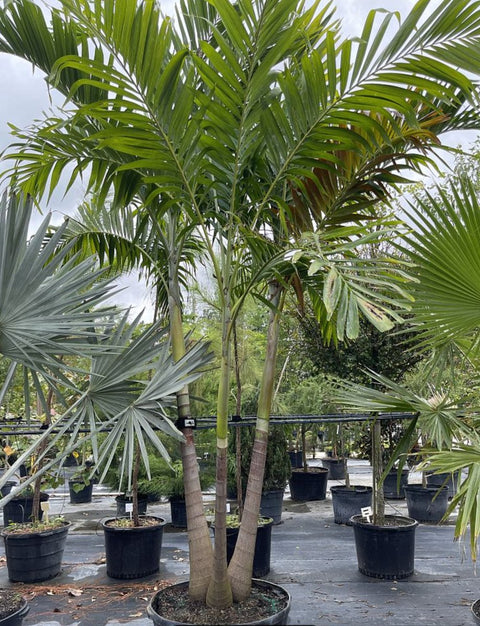A Guide to Choosing the Perfect Palm Tree for Your Garden
Welcome to our comprehensive guide comparing two popular palm trees for landscaping and tropical gardening: the Alexander Palm and the Christmas Palm. In this article, we will delve into the characteristics, growth habits, maintenance requirements, landscape uses, potential challenges, and more of these two stunning palm trees. Whether you're a seasoned gardener or a novice landscaper, this guide will provide you with valuable insights and help you make an informed decision for your garden.
Overview of Alexander Palm

The Alexander Palm, scientifically known as Archontophoenix Alexandrae, is a majestic palm tree that is native to Australia. It is characterized by its long feathery fronds and slender trunk, reaching heights of up to 50 feet. Its foliage creates a lush and tropical atmosphere, making it a popular choice for landscaping in warm climates. With its clumping growth habit, the Alexander Palm forms dense clusters of trees, providing excellent privacy and shade.
One of the unique features of the Alexander Palm is its adaptability to various soil and climate conditions. It can tolerate both sandy and clay soils and can thrive in tropical and subtropical climates. Its ability to withstand strong winds and occasional droughts makes it a reliable choice for coastal gardens.
Click Here to Explore the Alexander Palm
Introduction to Christmas Palm

The Christmas Palm, also known as Veitchia merrillii, is a small to medium-sized palm tree that is native to the Philippines. Its name comes from the vibrant red fruits it produces, resembling Christmas ornaments. The Christmas Palm has gained popularity in recent years due to its compact size, making it suitable for smaller gardens and landscaping projects. It typically reaches a height of 20 feet and features a single slender trunk with gracefully arching fronds.
One of the major advantages of the Christmas Palm is its visual appeal. The bright red fruits contrast beautifully against the green fronds, adding a festive touch to any garden or landscape. These fruits also attract various bird species, making the Christmas Palm a favorite among birdwatchers and nature enthusiasts.
Click Here to Explore the Christmas Palm - Single
Comparing Growth and Maintenance
When it comes to growth rates, the Christmas Palm is known for its faster growth compared to the Alexander Palm. While the Alexander Palm takes several years to reach its full height, the Christmas Palm grows at a faster pace, making it an ideal choice for those looking for quicker results in their landscaping projects.
In terms of soil and climate preferences, the Alexander Palm prefers well-drained soil and full sun exposure, while the Christmas Palm adapts well to a variety of soil types and can tolerate both full sun and partial shade. However, both palm trees require regular watering, especially during the hot summer months.
When it comes to maintenance, both palm trees require regular pruning to remove dead fronds and maintain their appearance. Fertilization should also be done regularly to provide essential nutrients for healthy growth. However, it is important to note that the Christmas Palm is generally considered more low-maintenance compared to the Alexander Palm, thanks to its slower growth and smaller size.
Landscape and Garden Uses
The Alexander Palm is a versatile palm tree that can be used in various landscape designs, such as tropical gardens, coastal landscapes, and poolside settings. Its tall and impressive stature makes it a perfect choice for providing shade and privacy. It can also be used as a focal point or to create a dramatic entrance when planted in rows.
On the other hand, the Christmas Palm is often used in smaller garden spaces, such as courtyards, patios, and urban landscapes. Its compact size and striking red fruits make it an excellent choice for adding color and visual interest to any garden. It can also be planted in clusters to create a vibrant focal point or as a backdrop for other plants.

Potential Challenges and Considerations
Like any plant, both the Alexander Palm and the Christmas Palm are susceptible to pests and diseases. Common pests that may affect these palm trees include palm aphids, scale insects, and spider mites. It is important to regularly inspect the trees and take appropriate measures such as using insecticidal soaps or natural predators to control the infestations.
One potential challenge in growing the Alexander Palm is its size. Due to its height and spread, it may not be suitable for smaller garden spaces or areas with overhead utilities. Careful consideration should be given to the planting location to ensure it has enough room to grow and doesn't cause any issues in the future.
As for the Christmas Palm, it may require protection during colder winter months, especially in areas with frost or freezing temperatures. Providing a layer of mulch around the base and covering the tree with a frost cloth can help protect it from potential damage.
Conclusion
In conclusion, both the Alexander Palm and the Christmas Palm offer unique characteristics and benefits for landscaping and tropical gardening. The Alexander Palm presents an impressive stature and adaptability to various soil and climate conditions, while the Christmas Palm adds a touch of festivity with its striking red fruits. Consider your specific needs, garden size, and climate when choosing between these two palm trees, and you'll be sure to enhance the visual appeal of your garden or landscape.
Additional Resources:
- Alexander Palm Care Guide
- Christmas Palm: The Perfect Addition to Your Garden
- Landscaping Ideas Using Palm Trees






























Comments (1)
This article says the Christmas palm grows faster than the Alexander palm. Then later in the article, it says the Christmas palm is a slower growing. Which is it?